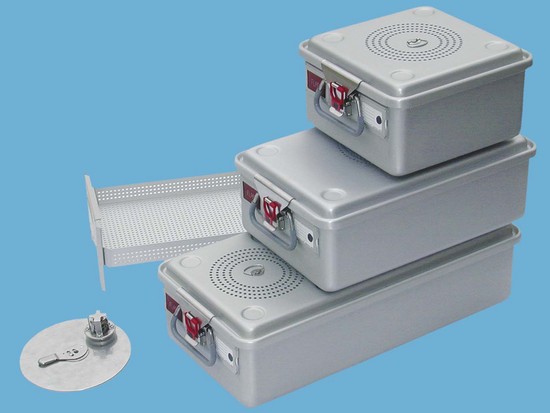CHAPTER 2 Sterilization packaging systems are required to secure instrument sets, provide for sterilant penetration of contents, and withstand multiple handling events during a prolonged period of storage and handling. There are two types of containment devices: rigid reusable sealed containers and case trays, which are designed to be wrapped. Rigid, reusable container systems provide an efficient, cost-effective way to package and protect surgical devices for sterilization, transport, storage, and aseptic presentation of contents. They are sealed systems and serve as an alternative to disposable and reusable sterilization wrap. A sterilization container’s rigid sides protect fragile devices within and eliminate the tears associated with sterilization wrap. Some containers are cleared for steam sterilization only, others for low-temperature sterilization. Only one is universal and corrosion resistant, cleared by the FDA for all current sterilization methods from steam to various low-temperature methods. Aseptic presentation is important with all sterilization packaging systems. To properly remove the inner basket or tray from the container, the sides of the basket must not touch the edge of the container or the contents will be considered contaminated. Furthermore, the contents of the container system must be dry. Wet packs are considered nonsterile, the only exception being for flashed items, properly cleaned, decontaminated, and sterilized for immediate use only. To manage wet packs, be sure that the contents are dry prior to sterilization. Preheat the load to reduce the formation of condensation during the cycle, evaluate the weight and density of the set, and review manufacturer’s recommendations for processing, including proper cool-down prior to transport to sterile storage. Plastic containers may require additional drying time as they do not have the thermal conductivity properties of aluminum and other metals. Metal materials used to construct containment devices must be corrosion resistant or treated to improve their corrosion resistance. Furthermore, these materials must not affect the biocompatibility of the device.
Sterilization Container Systems*
![]() Additional images are available at: evolve.elsevier.com/Tighe/instrumentation/
Additional images are available at: evolve.elsevier.com/Tighe/instrumentation/
Stay updated, free articles. Join our Telegram channel

Full access? Get Clinical Tree



